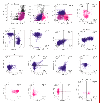Flow cytometry of lymph node aspirate can effectively differentiate the reactive lymphadenitis from the nodal non-Hodgkin lymphoma
DOI:
https://doi.org/10.3329/bsmmuj.v10i4.34560Keywords:
Aspirate, Flow cytometry, Lymph node, Nodal non-Hodgkin lymphoma, Reactive lymphadenitisAbstract
The purpose of the present study was to compare the routine cytology, histology, immunohistochemistry and flow cytometry in the diagnosis of nodal lymphoma cases. Thirty five cases of clinically suspected lymphoproliferative disorder were included in this study. After preparation of smears from the fine needle aspirates on the glass slides for cytology, the residual material was processed for flow cytometric immunophenotyping accordingly. Subsequently, histopathology and immunohistochemistry findings of selected cases of lymph node biopsy were correlated to confirm and compare the diagnosis. Flow cytometric immunophenotypes of most of the cases corresponded to the histological and immunohistochemical diagnoses, five cases showed marked shift in diagnosis (e.g. aggressive NK cell leukemia) which were later validated by clinical outcomes. Flow cytometry immunophenotyping had shown high sensitivity (96.4%) and specificity (100%) if we considered both histopathology and immunohistochemistry combined as gold slandered, while in comparison to immunohistochemistry, flow cytometry immunophenotyping had shown 100% sensitivity and specificity. However, despite the improved diagnostic capacity provided by flow cytometry, morphologic analysis obtained from histopathology remains the cornerstone in the diagnosis of lymphoma.
Downloads
676
278 Read
53

Additional Files
Published
How to Cite
Issue
Section
License
Copyright (c) 2017 Bishnu Pada Dey, Saumitra Chakravarty, Mohammed Kamal

This work is licensed under a Creative Commons Attribution-NonCommercial 4.0 International License.



